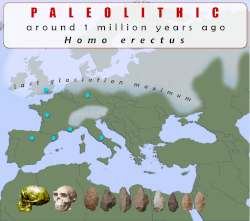Prehistoric western Europe

humans emerge in Europe
|
|
| Early Prehistory | |
|---|---|
| Lower Paleolithic |
Homo antecessor Homo heidelbergensis |
| Middle Paleolithic | Homo neanderthalensis |
| Upper Paleolithic | Homo neanderthalensis, Homo sapiens |
| Mesolithic | Homo sapiens population of all regions |
| Neolithic |
Homo sapiens Proto-farmers, herding, pottery |
| Late Prehistory | |
| Chalcolithic | Indo-Europeans, agriculture, |
| Bronze Age | Minoan Crete, Mycenaean Greece |
| Iron Age |
Greece, Rome Iberians, Germanic tribes |
|
|
|
Prehistoric Europe is the designation for the period of human presence in Europe before the start of recorded history, beginning in the Lower Paleolithic. As history progresses, considerable regional irregularities of cultural development emerge and increase. The region of the eastern Mediterranean is, due to its geographic proximity, greatly influenced and inspired by the classical Middle Eastern civilizations, and adopts and develops the earliest systems of communal organisation and writing. The Histories of Herodotus (from around 440 BC) is the oldest known European text that seeks to systematically record traditions, public affairs and notable events. In contrast, the European regions furthest away from the ancient centers of civilisation tended to be the slowest, regarding acculturation. In Northern and Eastern Europe in particular, writing and systematic recording was only introduced in the context of Christianization, after 1000 CE.
Widely dispersed, isolated finds of individual fossils of bone fragments (Atapuerca, Mauer mandible), stone artifacts or assemblages that suggest Lower Paleolithic palaeo-human presence are rare and typically separated by thousands of years. The karstic region of the Atapuerca Mountains in Spain represents the currently earliest known and reliably dated location of residence for more than a single generation and a group of individuals. Prolonged presence has been attested for Homo antecessor (or Homo erectus antecessor, Homo heidelbergensis and Neanderthals.
Homo neanderthalensis emerged in Eurasia between 350,000 and 600,000 years ago as the earliest body of European people, that left behind a substantial tradition, a set of evaluable historic data through rich fossil record in Europe's limestone caves and a patchwork of occupation sites over large areas, including Mousterian cultural assemblages.Modern humans arrived in Mediterranean Europe during the Upper Paleolithic between 45,000 and 43,000 years ago, and both species occupied a common habitat for several thousand years. Research has so far produced no universally accepted conclusive explanation as to what caused the Neanderthal's extinction between 40,000 and 28,000 years ago.
...
Wikipedia
